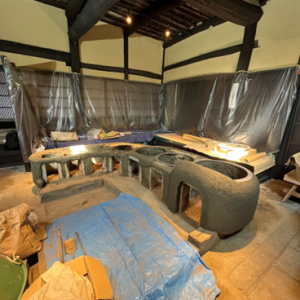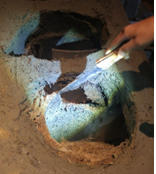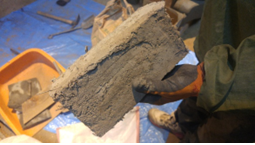Yamazaki House (Former Inoue House) Restoration Work Report II
Yoshie Doi
 Photographed by Junji Miyaoku on April 13, 2023 |
Following the restoration work from March, the restoration work continues in April this month. He was working on a schedule for a week. As you can see from this photo, only the foundation was left and the part to be repaired was removed.
While looking at the actual building, he told me, “It was restored in the Showa period and the parts are mixed with plaster and concrete. Concrete was invented after the Meiji period and dried quickly. It is strong and seems to last for about 40 years, but when it begins to deteriorate after about 40 years, the acceleration of deterioration is accelerated. It seems that the restoration work has been found to be hasty.
As you can see in the next picture, the fire from the grate causes the soil to crumble, and even though the concrete-coated part hasn’t collapsed, the inside of it crumbles down. Mr. Junji Miyaoku taught me that we can see the negative side of mixing natural things and chemical things.
 Dried bricks inside the deteriorated Okudosan |
 Dry brick |
This is a keen insight unique to Mr. Junji Miyaoku, who knows Okudosan inside and out. Experienced wisdom that has been sent to create Okudosan is pouring out in hospitals all over Japan and in Africa. Listening to the detailed explanation, I was impressed by the profound traditional industry of Japan.
Okudosan, since the stove is classified as a tool rather than a cultural property, it seems that there are no documents left behind. We can only measure the existing shape and the existing situation at that time. Restoration work allows us to see what it looked like decades ago.
In the restoration work this time, it seems that new chemicals have appeared in the former restoration work, and concrete was mixed. It has become clear that even materials that are momentarily strong and wonderful will deteriorate over time, accelerating faster than those made from nature.
So I remembered something. More than 1,500 years have passed since the fall of the Roman Empire, but the concrete of this era (roman concrete, a building joint material: concrete hardened by mixing sand, gravel, water, and cement) is still strong today.
Ancient Roman concrete is made from a mixture of volcanic ash, lime, volcanic rock and seawater. This seawater seems to play an important role, as new minerals form within the concrete over a period of more than 1,000 years, making it stronger and stronger.
A research team at the Lawrence Berkeley National Laboratory of the U.S. Department of Energy collected concrete made in the ancient Roman era and performed X-ray microanalysis. It is said that this layered mineral plays an important role in increasing the strength of concrete over a long period of time.
This mineral is produced when sea water, lime and volcanic ash mix and generate heat. ”The ancient Romans created a rock-like concrete that grew in a chemical reaction with seawater,” concluded University of Utah geologist Marie Jackson.
The analysis also seems to reveal that seawater washing up on the structure triggered a second phase of mineral growth, further strengthening the overall
concrete. (For those interested, see the online edition of American Mineralogist, July 3, 2017.)
I don’t know much about science, but I was impressed by the equation that when you multiply natural things with natural things, you multiply more and help concrete grow. Mr. Junji Miyaoku also made dried bricks by mixing soil, sand and straw and drying them in the sun. I will report back next month. Please look forward to it.
The end of document
